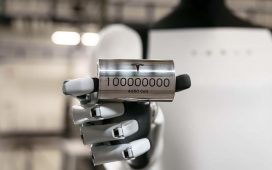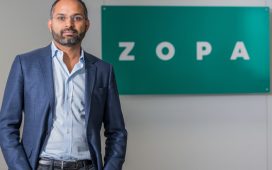This year’s Web Summit, in Lisbon, was all about artificial intelligence – and a robot sorting laundry.
Digit, a humanoid built by the US firm Agility Robotics, demonstrated how far AI has come in a few years by responding to voice commands – filtered through Google’s Gemini AI model – to sift through a pile of coloured T-shirts and place them in a basket.
It wasn’t a seamless demonstration but the enthusiastic response, nearly two years on from the launch of ChatGPT, reflected the excitement about all things AI that pervaded Europe’s biggest annual tech conference.
Talk of a bust in the AI boom could not be heard over the shouts of encouragement for Digit as it pondered different shades of garment.
Nonetheless, the voices of caution were there, discussing familiar themes such as safety, jobs and the climate, as AI comes to influence a huge range of industries. Here are some of the event’s discussion points about AI.
Job security
A key debate was: if millions of jobs are going to be displaced by AI, will they be replaced by new roles for humans as the technology creates fresh opportunities?
The possibility of entry-level jobs becoming casualties of displacement was raised a lot. Speakers talked about these jobs being affected in professional industries such as law, finance and even tech because AI tools, particularly AI “agents” that can carry out tasks autonomously, will be able to do relatively simple work, such as initial checking of contracts or handling queries from potential clients.
Sarah Franklin, the chief executive of Lattice, a US tech firm that provides a platform for company HR departments, said the shape of workforces would change as a result. Entry-level jobs formed the base of a workforce that narrowed as people filtered upwards into management and executive roles, she said. “AI can make this more of a diamond shape, where the entry levels are harder to get.”
She added: “The pace of innovation is outpacing education. That is a dangerous future if we don’t rapidly invest in ensuring that everyone is proficient with AI, especially entry-level workers.”
And then there is the question of replacing those eliminated jobs. Digit is being used in warehouses by GXO, a US logistics company, to lift boxes and place them on conveyor belts. According to the chief executive of Agility Robotics, Peggy Johnson, a new role could be created managing teams of Digits doing physical work.
“Employees who were previously doing this physical work, appreciate the fact that they can hand that off to Digit,” she said. “Then it allows them to do a number of other things, one of which is to be a robot manager.”
The climate
AI’s impact on the climate, most notably through the energy-hungry datacentres used to train and operate AI models, prompted warnings that competition for energy supply could pit tech firms against communities.
“I think there are real concerns to be raised about the implications for the climate and the implications for local communities that are also dependent on these energy infrastructures,” said Sarah Myers West of the AI Now Institute, which produces AI policy research.
She added that coal plants were being kept open to meet energy demand for datacentres in the US, while renewable energy resources could be diverted to AI firms and related infrastructure rather than for broader public use.
Microsoft’s president, Brad Smith, acknowledged the issue in a keynote speech.
“We can’t afford to just build datacentres and consume electricity without regard for what it means for a local community or for a country or for planet Earth,” he said.
Microsoft admitted this year that energy use related to its datacentres was endangering its “moonshot” target of being carbon negative by 2030.
Startups were a feature of the summit and climate-oriented investors regard the AI boom as a source of demand.
Shawn Xu, a partner at the US-based Lowercarbon Capital, a venture capital fund that invests in companies combating the climate crisis, said datacentres were “an opportunity to expand clean energy”. Lowercarbon’s investments include the UK business InRange, which connects rooftop solar sites to datacentres.
Edith Yeung, a general partner at the US VC firm Race Capital, said energy would be a focus of investment next year. “For 2025, AI strategy is energy strategy. It is a very critical pillar for AI infrastructure.”
after newsletter promotion
Safety
For all the AI boosterism, the event gave prominence to Prof Max Tegmark, a leading voice in the warnings about unrestrained development of the technology.
Tegmark, an AI specialist at the Massachusetts Institute of Technology, told a sizeable crowd that the industry was at a “fork in the road” where it could develop artificial general intelligence – AI systems that match or exceed human intelligence – that resulted in a “reasonable chance we’ll all be dead in 10 years” or living in a “dystopia” where humans are totally disempowered.
Will AI replace the creators?
The Peaky Blinders creator, Steven Knight, said creative professionals would be at the “forefront” of a battle between AI and humanity. However, computers would lose because they could not create the unexpected, he said. The issue was highlighted last month when it emerged the UK broadcaster ITV was advertising for a £95,000-a-year job involving the use of AI to “shape the future of content creation”.
Knight described AI’s approach to creative work as “taking previous experience, precedent, and presenting it in a different way”, and said the human approach to art souunded similar, but was “more than that”.
“When a creative human being creates something new, the reason it works is because it’s not expected.”
Knight was speaking alongside Marco Bassetti, the chief executive of the TV production group Banijay, which has launched a creative fund for ideas using AI.
“There are a lot of things that AI can do in order to improve creativity. It can cut a lot of time in finding an idea,” he told the Guardian. However, he added, humans still had the edge, and compared AI to a tool that helps make the finished product. “If you have a brush, it doesn’t mean you are able to do a painting.”
However, one experienced creative figure pointed to the emergence of AI products, such as Runway, that can generate convincing video images quickly.
“I think you’re going to see an enormous negative impact on the WPPs of the world and the big [advertising] holding companies. It’s not that they haven’t understood what’s going to happen, but would your start point really be: ‘I’ve got 100,000 employees who have no experience in AI’? No, it wouldn’t be,” said David Jones, the chief executive of Brandtech Group, an advertising startup using generative AI to create marketing campaigns.
Where next for the boom?
There was talk of the race to ever-more-powerful AI slowing, after reports that initial tests of unreleased models have been underperforming relative to expectations.
The recent breakthroughs have been more than enough to spur the launch of new companies, such as the British biotech startup Healx, which uses AI to search for cures for rare diseases, and Luminance, another UK firm, that offers companies a tailored AI model to do legal work.
Kanu Gulati, a partner at Khosla Ventures, a California VC firm whose investments include the ChatGPT developer OpenAI, said companies were emerging that, even if they didn’t build the models, were taking advantage of them. This was a key – and necessary – development for investors and tech firms looking for a return on their multibillion dollar investments in AI breakthroughs. “New business models can now get created,” Gulati said.







